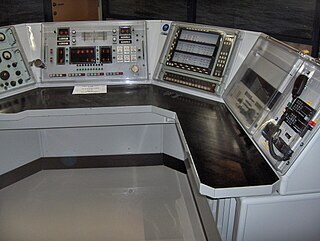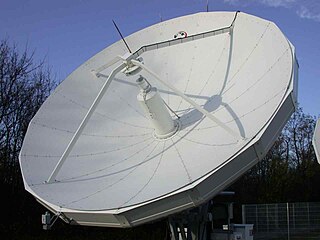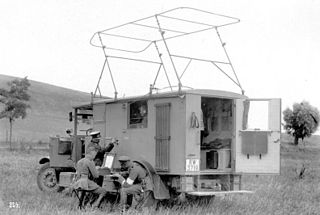This page is based on this
Wikipedia article Text is available under the
CC BY-SA 4.0 license; additional terms may apply.
Images, videos and audio are available under their respective licenses.

A coast radio station is an on-shore maritime radio station which may monitor radio distress frequencies and relays ship-to-ship and ship-to-land communications.

Land mobile-satellite service is – according to Article 1.27 of the International Telecommunication Union´s (ITU) Radio Regulations (RR) – defined as «A mobile-satellite service in which mobile earth stations are located on land.»

Land station is – according to Article 1.69 of the International Telecommunication Union´s (ITU) ITU Radio Regulations (RR) – defined as «A radio station in the mobile service not intended to be used while in motion.»

Mobile earth station is – according to Article 1.68 of the International Telecommunication Union´s (ITU) ITU Radio Regulations (RR) – defined as «An earth station in the mobile-satellite service intended to be used while in motion or during halts at unspecified points.»

A land earth station is – according to Article 1.70 of the International Telecommunication Union´s (ITU) ITU Radio Regulations (RR) – defined as «An earth station in the fixed-satellite service or, in some cases, in the mobile-satellite service, located at a specified fixed point or within a specified area on land to provide a feeder link for the mobile-satellite service.»

Aeronautical mobile service is – according to Article 1.32 of the International Telecommunication Union´s (ITU) Radio Regulations (RR) – defined as «A mobile service between aeronautical stations and aircraft stations, or between aircraft stations, in which survival craft stations may participate; emergency position-indicating radiobeacon stations may also participate in this service on designated distress and emergency frequencies.»

Aeronautical station is – according to Article 1.81 of the International Telecommunication Union´s (ITU) ITU Radio Regulations (RR) – defined as «A land station in the aeronautical mobile service. In certain instances, an aeronautical station may be located, for example, on board ship or on a platform at sea.»

An aircraft station is – according to Article 1.83 of the International Telecommunication Union´s (ITU) ITU Radio Regulations (RR) – defined as "A mobile radio station in the aeronautical mobile service, other than survival craft station, located on board an aircraft".

Ship earth station is – according to Article 1.78 of the International Telecommunication Union's (ITU) ITU Radio Regulations (RR) – defined as «A mobile earth station in the maritime mobile-satellite service located on board ship.»

Land mobile earth station is – according to Article 1.74 of the International Telecommunication Union´s (ITU) ITU Radio Regulations (RR) – defined as «A mobile earth station in the land mobile-satellite service capable of surface movement within the geographical limits of a country or continent.»

Coast earth station, also called the coast earth radio station is – according to article 1.76 of the International Telecommunication Union´s (ITU) ITU Radio Regulations (RR) – defined as «An earth station in the fixed-satellite service or, in some cases, in the maritime mobile-satellite service, located at a specified fixed point on land to provide a feeder link for the maritime mobile-satellite service.»
Each radio station shall be classified by the service in which it operates permanently or temporarily.

Radionavigation land station is – according to article 1.88 of the International Telecommunication Union´s (ITU) ITU Radio Regulations (RR) – defined as «A radio station in the radionavigation service not intended to be used while in motion.»

Base earth station is – according to article 1.72 of the International Telecommunication Union´s (ITU) ITU Radio Regulations (RR) – defined as «An earth station in the fixed-satellite service or, in some cases, in the land mobile-satellite service, located at a specified fixed point or within a specified area on land to provide a feeder link for the land mobile-satellite service.»

Aeronautical earth station is – according to Article 1.82 of the International Telecommunication Union´s (ITU) ITU Radio Regulations (RR) – defined as «An earth station in the fixed-satellite service, or, in some cases, in the aeronautical mobile-satellite service, located at a specified fixed point on land to provide a feeder link for the aeronautical mobile-satellite service.»
Radiodetermination station is – according to article 1.86 of the International Telecommunication Union´s (ITU) ITU Radio Regulations (RR) – defined as «A radio station in the radiodetermination service.»
Radiolocation mobile station is – according to article 1.89 of the International Telecommunication Union´s (ITU) ITU Radio Regulations (RR) – defined as «A radio station in radiolocation service intended to be used while in motion or during halts at unspecified points.»

radiolocation land station is – according to article 1.90 of the International Telecommunication Union´s (ITU) ITU Radio Regulations (RR) – defined as «A radio station in radiolocation service not intended to be used while in motion.»

Radio direction-finding station is – according to article 1.91 of the International Telecommunication Union's (ITU) ITU Radio Regulations (RR) – defined as «A radiodetermination station using radio direction-finding.»
Ship's emergency transmitter is – according to article 1.99 of the International Telecommunication Union´s (ITU) ITU Radio Regulations (RR) – defined as «A ship's transmitter to be used exclusively on a distress frequency for distress, urgency or safety purposes.»

Aircraft earth station is – according to Article 1.84 of the International Telecommunication Union´s (ITU) ITU Radio Regulations (RR) – defined as «A mobile earth station in the aeronautical mobile-satellite service located on board an aircraft.»

























